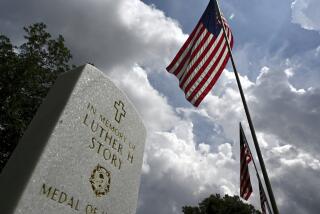Skull of Rebel Taken From Battlefield Returned, Buried
- Share via
SPOTSYLVANIA, Va. — With a light breeze rustling a Confederate flag, the remains of a soldier known only as “Rebel Butler” were buried Saturday, 132 years after he died in one of the Civil War’s fiercest battles.
Men in gray wool uniforms and women in black veils dropped clods of red clay onto a tiny coffin containing a skull that was found on the battlefield at Spotsylvania Courthouse and carried home as a memento by a Union soldier.
The burial helps right a wrong done to the countless families unable to bury sons lost on battlefields far from home, said Gregory T. Collins, a Civil War buff who led two dozen others in period garb at the grave site in the Spotsylvania Confederate Cemetery.
“The tears for this man were shed long ago, perhaps by a sweetheart, maybe a wife and children, certainly a mother and father,” Collins said during a 30-minute graveside service.
About 20,000 men fell dead or wounded in May 1864 at Spotsylvania Courthouse, a speck of a town in the northern Virginia countryside.
A year after the battle, a Union doctor found the skull on the battlefield. Historians surmise that the body was hastily buried in a shallow grave and the soil eventually eroded.
The doctor labeled the skull “Rebel Butler,” apparently taking the name from bits of uniform found with it, and took it home.
The skull was donated to the Henry County Historical Society Museum in New Castle, Ind., in 1923, and was displayed for 70 years, the curator said.
The Sons of Confederate Veterans, a service league of Southern Civil War descendants, arranged the military burial.
Retter and the others said they didn’t want their actions to be misconstrued.
“This has nothing whatsoever to do with slavery,” Collins said afterward. “This is a burial for a soldier who gave the full measure for his cause.”
More to Read
Sign up for Essential California
The most important California stories and recommendations in your inbox every morning.
You may occasionally receive promotional content from the Los Angeles Times.












